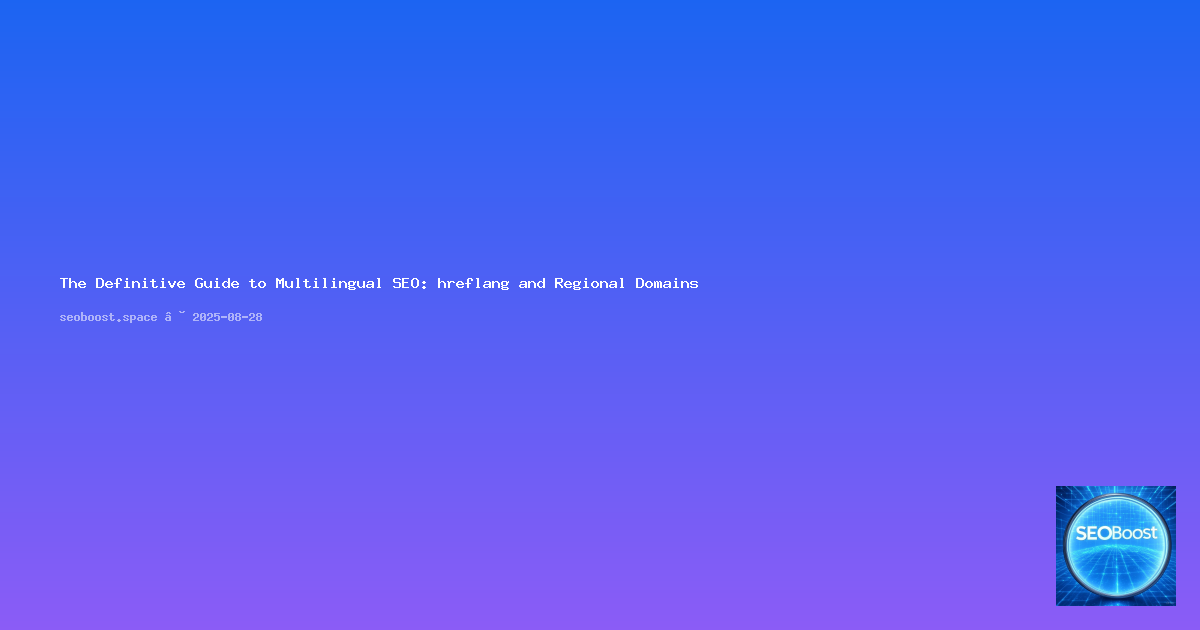The Definitive Guide to Multilingual SEO: hreflang and Regional Domains
Published: 2025-08-28 09:54:22

Introduction
In today's globalized world, businesses are expanding internationally to reach new audiences and grow their customer base. However, this expansion comes with its own set of challenges, including multilingual SEO. Multilingual SEO involves optimizing websites for different languages and regions. Two common approaches to multilingual SEO are hreflang and regional domains. In this guide, we'll explore how to use hreflang and regional domains to improve your website's international search engine rankings and user experience.
1. Understand hreflang
Hreflang is a tag that tells search engines which page to show a user based on their location and language preferences. It helps prevent duplicate content penalties and improves the user experience by serving the right content in the right language. Here's how to use hreflang:
- Use the hreflang attribute in the header or sitemap to specify language and regional preferences
- Use the correct values for hreflang (e.g., x-default, x-hreflang, x-locale, x-variant)
- Use the correct syntax (e.g., hreflang="x-default", hreflang="x-hreflang-country-region", hreflang="x-hreflang-language-region")
- Use the correct values for language and region codes (e.g., en, fr, es-ES, es-MX)
- Use rel="alternate" for regional pages
- Use rel="canonical" for language-neutral pages
- Test hreflang with Google Search Console
2. Use regional domains
Regional domains are country-specific TLDs (e.g., .co.uk, .fr, .de). Here's how to use them:
- Use the correct TLD for the region (e.g., .co.uk for the UK, .fr for France, .de for Germany)
- Use the correct subfolders (e.g., example.com/fr/ for France, example.com/de/ for Germany)
- Use the correct hreflang for regional pages
- Use Google Search Console to verify regional domains
3. Use Google's Search Console for hreflang and regional domains
Google's Search Console helps you monitor and maintain multilingual SEO. Here's how to use it:
- Add your website and verify ownership
- Use the Multilingual Sitemaps report to see hreflang errors
- Use the Search Appearance > International Targeting report for regional domains
- Use the Search Analytics report for location data
4. Use Google Analytics for location data
Google Analytics helps you understand user behavior. Here's how to use it:
- Add your website and verify ownership
- Use the Audience > Geo > Location report
- Use the Behavior > Site content > Landing pages report
5. Use Google Ads for regional targeting
Google Ads lets you target specific regions. Here's how to use it:
- Create a new campaign
- Select your target location
- Use location targeting for keywords and bidding
6. Use Google My Business for regional listings
Google My Business helps you manage regional locations. Here's how to use it:
- Add your business
- Set your address and region
- Use Google Posts for local SEO
7. Use HTTP headers for hreflang and regional domains
HTTP headers tell search engines your language and region. Here's how to use them:
- Use Content-Language: en-US for English in the US
- Use Content-Location: US for the US
8. Use Google's Translate Tool for content
Google's Translate Tool helps you translate content. Here's how to use it:
- Copy and paste content
- Use the correct language and region
- Translate accurately and naturally
9. Use Google's PageSpeed Insights for multilingual pages
PageSpeed Insights checks page speed. Here's how to use it:
- Analyze your pages
- Fix page speed issues
10. Use Google's Mobile-Friendly Test for multilingual pages
Google's Mobile-Friendly Test checks mobile optimization. Here's how to use it:
- Test your pages
- Fix mobile issues
Conclusion
Multilingual SEO involves hreflang and regional domains. Use them together for better rankings and user experience. Follow these tips for international success.
Hreflang and regional domains are essential for multilingual SEO. Use them effectively to reach global audiences.
In today's globalized world, businesses are expanding internationally to reach new audiences and grow their customer base. However, this expansion comes with its own set of challenges, including multilingual SEO. Multilingual SEO involves optimizing websites for different languages and regions. Two common approaches to multilingual SEO are hreflang and regional domains. In this guide, we'll explore how to use hreflang and regional domains to improve your website's international search engine rankings and user experience.
1. Understand hreflang
Hreflang is a tag that tells search engines which page to show a user based on their location and language preferences. It helps prevent duplicate content penalties and improves the user experience by serving the right content in the right language. Here's how to use hreflang:
- Use the hreflang attribute in the header or sitemap to specify language and regional preferences
- Use the correct values for hreflang (e.g., x-default, x-hreflang, x-locale, x-variant)
- Use the correct syntax (e.g., hreflang="x-default", hreflang="x-hreflang-country-region", hreflang="x-hreflang-language-region")
- Use the correct values for language and region codes (e.g., en, fr, es-ES, es-MX)
- Use rel="alternate" for regional pages
- Use rel="canonical" for language-neutral pages
- Test hreflang with Google Search Console
2. Use regional domains
Regional domains are country-specific TLDs (e.g., .co.uk, .fr, .de). Here's how to use them:
- Use the correct TLD for the region (e.g., .co.uk for the UK, .fr for France, .de for Germany)
- Use the correct subfolders (e.g., example.com/fr/ for France, example.com/de/ for Germany)
- Use the correct hreflang for regional pages
- Use Google Search Console to verify regional domains
3. Use Google's Search Console for hreflang and regional domains
Google's Search Console helps you monitor and maintain multilingual SEO. Here's how to use it:
- Add your website and verify ownership
- Use the Multilingual Sitemaps report to see hreflang errors
- Use the Search Appearance > International Targeting report for regional domains
- Use the Search Analytics report for location data
4. Use Google Analytics for location data
Google Analytics helps you understand user behavior. Here's how to use it:
- Add your website and verify ownership
- Use the Audience > Geo > Location report
- Use the Behavior > Site content > Landing pages report
5. Use Google Ads for regional targeting
Google Ads lets you target specific regions. Here's how to use it:
- Create a new campaign
- Select your target location
- Use location targeting for keywords and bidding
6. Use Google My Business for regional listings
Google My Business helps you manage regional locations. Here's how to use it:
- Add your business
- Set your address and region
- Use Google Posts for local SEO
7. Use HTTP headers for hreflang and regional domains
HTTP headers tell search engines your language and region. Here's how to use them:
- Use Content-Language: en-US for English in the US
- Use Content-Location: US for the US
8. Use Google's Translate Tool for content
Google's Translate Tool helps you translate content. Here's how to use it:
- Copy and paste content
- Use the correct language and region
- Translate accurately and naturally
9. Use Google's PageSpeed Insights for multilingual pages
PageSpeed Insights checks page speed. Here's how to use it:
- Analyze your pages
- Fix page speed issues
10. Use Google's Mobile-Friendly Test for multilingual pages
Google's Mobile-Friendly Test checks mobile optimization. Here's how to use it:
- Test your pages
- Fix mobile issues
Conclusion
Multilingual SEO involves hreflang and regional domains. Use them together for better rankings and user experience. Follow these tips for international success.
Hreflang and regional domains are essential for multilingual SEO. Use them effectively to reach global audiences.
Share:
Telegram





